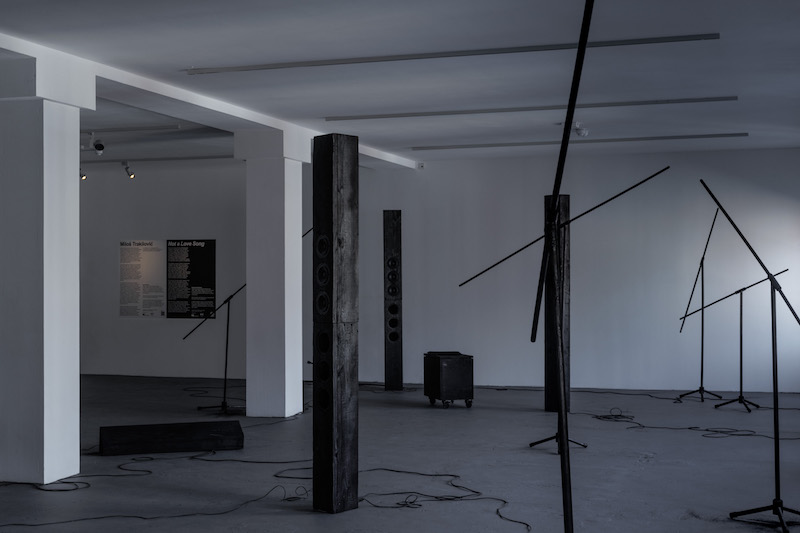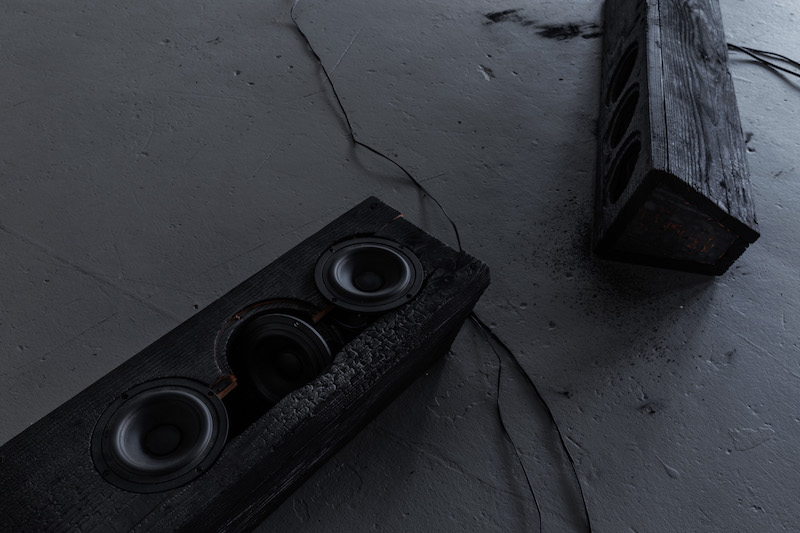by Andrey Shental // Feb. 25, 2025
This article is part of our feature topic Cycles.
Miloš Trakilović’s solo exhibition ‘Not a Love Song,’ currently on display at KW, explores the entanglement of sound, history and technology. The artist trained neural networks on war-zone recordings to detect latent tonalities in the pop tracks from Yugoslavia in the years leading up to the Bosnian War. The result is a dystopian, quasi-production studio filled with a constantly evolving soundscape, where extrapolated fragments are reassembled according to melodic structures commonly found in love songs. This generative work speculates on how cultural production might anticipate the looming catastrophe. We spoke to Trakilović about the persistence of war in cultural memory, the failure of language in conveying conflict and the cyclical nature of violence.

Miloš Trakilović: ‘564 Tracks (Not a Love Song Is Usually a Love Song),’ 2025, installation view of the exhibition ‘Miloš Trakilović – Not a Love Song’ at KW Institute for= Contemporary Art, Berlin 2025 // Courtesy the artist, photo by Frank Sperling
Andrey Shental: The traumatic experience of war is a subject that repeats itself throughout your practice. In psychoanalysis, the compulsion to repeat a traumatic experience, breaks the linearity of time. How does it inform your own practice?
Miloš Trakilović: I was born in November 1989, a particularly turbulent time, marked by the fall of the Berlin Wall and the collapse of the former Eastern Bloc. Dissolution and loss, in a way, remain recurring themes in both my life and my work. I came to the understanding that different generations have processed the conflict in former Yugoslavia differently. For those who experienced it as adults, the war appears almost as an anomaly in their lives: there was a pre-war time, a war period and then a post-war time. But, for my generation, such distinct categories don’t exist—we don’t have a clear pre-war period. This childhood experience is quite difficult to articulate, the conflict proliferates and reverberates in our lives. That said, I personally avoid using the word “trauma.” For me, it carries the connotation of something insular and secluded within a subjective experience. Although I don’t shy away from bringing up personal departure points, my work is mostly an attempt to grasp how those conditions and conflicts still actively shape the world today, oftentimes highlighting or calling for a sense of complicity.
AS: Most of your works take the form of essay films and lecture performances, where your voice directly guides the narrative. ‘564 Tracks (Not a Love Song Is Usually a Love Song),’ however, is a music-based sound installation, which gives less control over your message. Why did you choose this medium?
MT: The Bosnian War was one of the most documented and broadcast conflicts of its time. It left behind a lot of mediations that kept on circulating and over time became inseparable from my own memories. From an early age, this prompted me to question the power of images and their relationship to categories like “truth” and “meaning.” This inquiry was more strongly present in my earlier lecture-based works, whether didactic or more poetic formats. My new piece was influenced by the general state of the world and the unfolding genocidal campaign in Gaza after October 7th. I often found myself muted by the repetition of horrors that felt disturbingly familiar. Unlike before, I could not express myself in the same way—I felt a profound failure of language.
In this work, I draw on the interregnum period before the war broke out in Bosnia in 1992. Later on, the sounds of war would become imprinted in my body as a result of being exposed to this conflict. This lasting heightened sensitivity to sound is to some degree a departure point for this work. More broadly, I was interested in testing this hypothesis if the war could have somehow been predicted or foreshadowed in the cultural production of that time. Revisiting the atmosphere of a society on the brink of disaster somehow, for me, drew unsettling parallels to our present moment. Working with sound—especially musical fragments—I felt I could access an emotional dimension that language or imagery often cannot fully convey.

Miloš Trakilović: ‘564 Tracks (Not a Love Song Is Usually a Love Song),’ 2025, installation view of the exhibition ‘Miloš Trakilović – Not a Love Song’ at KW Institute for= Contemporary Art, Berlin 2025 // Courtesy the artist, photo by Frank Sperling
AS: Could you say a few words on the formal aspects of your work? The speakers are located in black, vertical, minimalist structures that appear as if they have survived shelling.
MT: This might be the closing chapter of a body of work I’ve been developing over the past years. As someone trained in moving-image, I often worked with very bright colors—yellow, blue, green. But this project is reduced to grayscale. It evokes a studio that has been scorched and burned, a kind of an abandoned dystopian production set. The image on the screens is a hallucinatory, audio-responsive visual—for which I worked with Tim Novikov—its purpose is simply to brighten the space. The installation is made from charred objects, like microphone stands and speaker towers that play a processual composition, with no beginning or end, in this dystopian setting it is only the soundscape that remains and continues infinitely.
AS: When I saw your work, I immediately thought of hauntology—the music movement theorized by Simon Reynolds and Mark Fisher. In the 2000s, it became popular to use spectral sounds from old music technologies as lingering ghosts of the recent past.
MT: It is definitely haunting. There is an aura of the past directly echoing through, as the work is built from extrapolated fragments of 564 actual pop tracks recorded between the fall of the Berlin Wall in 1989 and the outbreak of war in Bosnia in April 1992. The second model is fed these fragments to produce a soundscape that follows the melody of a love song, so in that sense, it does reflect the overall musical production of a bygone era—a society on the verge of conflict. I see how it aligns with hauntology, but my influences also came from elsewhere. There’s Paul Virilio’s idea that sound inherently reveals the future, since it reaches our senses before anything that probes into the visual field. Similarly, the Italian Futurists who incorporated industrial and machinic noises, explored how music can foreshadow or forebode societal conflict.

Miloš Trakilović: ‘564 Tracks (Not a Love Song Is Usually a Love Song),’ 2025, installation view of the exhibition ‘Miloš Trakilović – Not a Love Song’ at KW Institute for= Contemporary Art, Berlin 2025 // Courtesy the artist, photo by Frank Sperling
AS: You trace the catastrophe—the Bosnian War—as if it were something imminent. This method is used, for instance, in Siegfried Kracauer’s ‘From Caligari to Hitler’ (1947), where he retroactively identifies authoritarian tendencies in Weimar cinema. Your approach is also teleological.
MT: This is often referred to as “black swan theory,” where an event occurs, and only in hindsight do people connect the dots to make some kind of sense of it. For me, this project was about testing the predominant technologies of today. Working with AI, I wanted to push my understanding beyond the black-box interfaces we are typically presented with. By building these technological pipelines, I tested the hypothesis that in the pre-conflict years (1989–1992), there was indeed an intensified sonic dimension within cultural production—certain tones and tonalities that, in retrospect, seemed to anticipate the coming conflict. The violent dissolution of Yugoslavia was already palpable on many fronts, even though the war had not yet begun. As Gramsci famously stated: “The crisis consists precisely in the fact that the old is dying and the new cannot be born.” This suspended state, the interregnum, is both unsettling and compelling, I was interested in exploring its resonance with our present moment.
AS: What was your method?
MT: I tried to “objectively” test that. First, I trained a neural network to recognize a vast library of war-related sounds—not just from the Balkan wars, but also from Ukraine, because it is very well-digitized. It wasn’t just bomb drops, machine guns, tanks and explosions, but also sirens, suspense, a broad spectrum of sounds. Once the model was trained on this material, we applied it to the music. It calculates a complex set of metrics and assigns high probabilities and we focused on tonalities with a 60–80% similarity. I stripped the tracks of vocals because I wanted to avoid language and work more with the atmosphere of the time. The next step was developing another model trained on love songs. This model takes all the extracted fragments and synthesizes them, following the logic of a love song. The result is a processual composition—an unsingable love song that can be very dark and sinister, and at times more melodic and gentle.

AS: In the description of ‘564 Tracks’ you claim: “to see the future today means looking into the past.” What do you mean by that?
MT: Working with AI is cyclical in a sense, as you need data from the past to process something in the present by identifying patterns and projecting future probabilities. I embraced this approach not only technologically, but also conceptually. Looking into this specific moment in time, there’s so much to learn from this context. The former Eastern Bloc—from the Soviet Union to the Balkans—has experienced phenomena that are now global trends: the rise of nationalism, populism, privatization and extreme inequality. These issues are resurfacing globally through authoritarian figures like Trump, Musk and the unprecedented rule of Big Tech, etc. I think it’s urgent to understand that certain positions we inhabit are not ones of lagging behind; they are in a way becoming more and more from an almost future-like perspective. Perhaps, carrying those experiences, I have become more attuned to recognizing things around me with greater urgency. Looking at some of the events unfolding in the world, the present often feels like a very scary déjà vu.
AS: There is a naive liberal narrative of the decline of violence, i.g. Steven Pinker’s ‘The Better Angels of Our Nature,’ which claims that statistically, fewer people are killed, but we are just more sensitive to it. Would you say that violence is cyclical instead?
MT: My entire existence has been shaped by such an event, and my work is often an attempt to understand it. I can’t claim to have reached a final conclusion—it remains an ongoing exploration. What I do notice, however, is that on the level of perception conflict has become increasingly complex to grasp.
Take the Bosnian War, for instance. It was live-broadcasted through centralized television media, making it nearly impossible to look away. The power structures behind these media landscapes were perhaps more apparent, and the way the war was perceived was shaped by a relatively uniform media landscape, yet the question of desensitization persisted. Today, while many conflicts are documented and streamed to an even larger degree, they may never reach you, depending on how algorithms are instructed to curate information online. The circulation of and the very nature of these events has become more fragmented and opaque, making them harder to grasp.
Cycles of violence seem to be repeating—if not worsening—but that doesn’t necessarily mean we have a clearer understanding of the deeper forces driving them or that we have become more sensitive to them, unfortunately.
Artist Info
Exhibition Info
KW Institute for Contemporary Art
Miloš Trakilović: ‘Not a Love Song’
Exhibition: Feb. 15-May 4, 2025
kw-berlin.de
Auguststraße 69, 10117 Berlin, click here for map




















